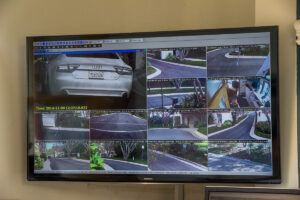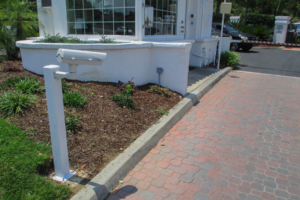If you oversee a residential community or manage a commercial property, you’re well aware that monitoring vehicular activity involves much more than resolving parking disputes.
Effective management requires keeping tabs on drivers, their vehicles, the timing of arrivals and departures, and crucially, determining which vehicles are authorized to enter. Manually inspecting each vehicle is not only time-consuming but also prone to errors.
This is where the power of License Plate Recognition (LPR) technology comes into play. LPR technology enhances security measures and streamlines access control in gated communities, buildings, and clubs.
But with so many options out there, how do you know what to look for in LPR software? Let’s dig in and find out.
In this article:
- What is License Plate Recognition (LPR)?
- The Benefits of Implementing LPR Systems
- Who Should Use LPR Systems?
- Key Features to Look for in LPR Software
- Key Points for Choosing Your LPR System Provider
- Challenges in LPR System Implementation
- Take the Next Step Towards Enhanced Security with Proptia’s LPR Technology
What is License Plate Recognition (LPR)?
At its core, License Plate Recognition (LPR) technology is a sophisticated system designed to read and record the license plates of vehicles.
Using high-definition cameras and advanced image-processing algorithms, LPR captures a vehicle’s license plate image as it enters or exits a premises. The software then analyzes these images, extracting the alphanumeric characters of the plate and converting them into a text entry that can be checked against a database.
This process involves a few critical technological components:
- High-Resolution Cameras: Essential for capturing clear, readable images, regardless of the lighting conditions or the speed of the vehicle.
- Optical Character Recognition (OCR): Responsible for interpreting the characters on the license plate from the image captured by the cameras.
- Machine Learning Algorithms: Enhance character recognition accuracy and adapt to various plate designs and anomalies.
- Integration Tools: Software that integrates the LPR data with other security systems like gate controls or traffic management systems.
Together, these technologies form a reliable and efficient system that can drastically improve security and operational efficiency in managed properties.
The Benefits of Implementing LPR Systems
License Plate Recognition (LPR) systems are ideal for enhancing safety and streamlining operations in gated communities, office buildings, and private clubs. Let’s break down their main perks:
- Better Security: LPR systems keep an eye out in real-time. They give security teams a big hand in managing who gets into the property, boosting protection against intruders.
- Efficient Management: These smart systems track cars coming and going automatically—no more manual logs. This means quicker entries and exits with fewer mix-ups.
- A Hand to Law Enforcement: When things go wrong, LPR data on vehicle movements can be invaluable for police work. It aids investigations by keeping tabs on suspects or mapping out emergency traffic flow.
In short, if you’re tasked with overseeing property security or operations, integrating an LPR system is a strong move toward upholding high operational standards.

Who Can Benefit from Using an LPR System?
License plate recognition (LPR) tech is a real workhorse when it comes to handling tasks that involve keeping tabs on vehicles. Let’s look at where this technology really shines:
- Gated Communities: It’s all about safety and smooth operations here. LPR helps make sure only the cars that are supposed to be there get in, while also making visitors feel welcome without the hassle.
- Commercial Buildings: Ever been stuck in parking chaos? Not with LPR. This tech keeps track of who’s arriving and leaving – perfect for busy office buildings or bustling shopping complexes.
- Educational Campuses: Keeping students safe is a top priority. With LPR, schools can keep an eye on which cars come onto campus, creating peace of mind for everyone involved.
- Government Facilities: Some places need extra protection, and that’s where LRP steps in – controlling access so only authorized vehicles can enter those critical areas.
Using LPR means you’re not just upping security; you’re also streamlining how things run behind the scenes, ensuring everyone – from daily visitors to long-term residents – stays safe and sound.
Key Features to Look for in LPR Software
When selecting License Plate Recognition (LPR) software, it’s essential to prioritize certain key features that ensure the system is robust, user-friendly, and secure. These features not only facilitate smoother operations but also bolster security and privacy. Here are a few of the must-haves when it comes to LPR software and systems.
Accuracy and Reliability
The foremost requirement of an LPR system is its ability to perform accurately across various environmental conditions. High-performance LPR software can:
- Perform in All Light and Weather: Maintain reliable performance through the night, and in fog, rain, or other demanding weather situations.
- Record Complete Vehicle Information: Identify not just license plates but also vehicle make, model, color, and type for detailed tracking and reports.
- Operate During Power Failures: Capable of integrating with backup power sources to stay operational during unforeseen power outages.
Integration Capabilities
A seamless integration with existing security and operational systems is crucial for maximizing the effectiveness of LPR software. Effective LPR systems should:
- Work with Existing Security Infrastructure: Integrate smoothly with other security systems like CCTV, access controls, and traffic management systems.
- Support Various Camera Types: Compatibility with most existing IP cameras on the market ensures that upgrades to LPR systems are cost-effective and minimally disruptive.
- Connect With Existing Hardware: The system is built to link up effortlessly with present network infrastructure without necessitating costly overhauls.
User-Friendly Interface
For LPR software to be effective, it must be accessible to those who use it daily. Look for software that offers:
- Intuitive Dashboards and Controls: Easy-to-navigate interfaces for security personnel and administrators help streamline operations and reduce training time.
- Efficient Visitor and Vendor Management: Facilitate the addition of temporary and permanent visitor plates, reducing wait times and enhancing the visitor experience.
Data Protection and Privacy
With the increasing emphasis on data security and privacy, it’s critical that LPR systems adhere to stringent standards. Effective systems should:
- Secure Data Handling: Automate the storage of all license plate data securely in the cloud, ensuring data integrity and compliance with privacy laws.
- Controlled Data Access: Implement robust access controls to ensure that only authorized personnel can view or manipulate sensitive information.
Powerful Reporting and Analytics
Advanced reporting capabilities are what set leading LPR systems apart. Such systems can:
- Detailed Filtering and Search Options: Filter reports by vehicle type, attributes, time parameters, pass types, and tags to quickly locate specific data.
- Rich Data Reports: Generate detailed reports on vehicle activity, including entry and exit times, duration of stay, and unauthorized vehicle activity. Reports like Muster Reports, Overstay Reports, and Cut Through Reports are vital for effective management and security assessment.
Putting in place a strong license plate recognition system with these capabilities can greatly improve safety. It makes things easier to handle and offers helpful information that supports the work of law enforcement and security teams. This leads to a more secure and well-run space for residents and visitors alike.
Key Points for Choosing Your LPR System Provider
Choosing the right vendor for your License Plate Recognition (LPR) system is as crucial as the technology itself. A reliable vendor not only provides a robust product but also ensures that it aligns with your specific needs and operational requirements.
Here are some critical criteria to consider and tips for effectively evaluating potential LPR software.
Experience and Reputation
Look for vendors with a proven track record of successful implementations across similar properties or industries. Their experience often translates into a deeper understanding of client needs and potential security challenges.
Support and Service
Ensure that the vendor offers comprehensive support and maintenance services. Effective troubleshooting, regular updates, and responsive customer service are essential for the smooth operation of any security system.
Cost-Effectiveness
While the initial cost is a factor, consider the total cost of ownership which includes installation, maintenance, and potential upgrades. A cost-effective solution doesn’t compromise quality for price but offers the best value over its operational lifespan.
Software Demos and Pilot Testing
Participate in detailed demos to understand the software’s interface and features. Check how well it integrates with your existing systems and whether it meets your specific security requirements.
Opt for a pilot test if possible. Implementing the LPR system in a controlled environment will help you assess its functionality and effectiveness in real-world conditions. It’s also an opportunity to see how well the vendor supports the implementation and addresses any issues that arise.
Challenges in LPR System Implementation
Implementing License Plate Recognition (LPR) systems offers numerous advantages, but it’s not without its hurdles. Technical concerns like inaccurate readings from blurry images or quickly passing cars can impact the system’s reliability.
Integrating LPR technology into current security setups or operational frameworks also poses potential complications during installation.
Privacy is also a significant factor. We must handle and store data in line with legal requirements for data protection. It’s vital to safeguard personal information so that only those who are authorized have access to it—a key aspect of preserving trust and integrity in the use of LPR systems.
Take the Next Step Towards Enhanced Security with Proptia’s LPR Technology
Property managers and HOA board members understand that improving safety and efficiency is a top priority. This is where License Plate Recognition (LPR) technology really shines, offering a smart way to step up your community’s access control systems.
When you’re ready to enhance your security measures, it’s critical to select an option designed not just for today but one that will continue to serve well into the future.
You can learn more about how our state-of-the-art LPR technology could upgrade your property management by checking out our insights page.
We also invite you to reach out so our team can discuss customized solutions with you and arrange a demonstration of what these improvements might look like in action for your properties.


